There will likely always be room for improvement with regard to the fitness client’s mobility, so having a short list of go-to exercises that can apply to everyone is a great addition to every trainer’s toolbox. The beauty of the following three exercises is the reproducibility and simplicity of using them to evaluate mobility issues.
Here are my three favorite human movements that every fitness professional can use for better movement, injury prevention, and true performance enhancement:
Wall Angels
Here’s a fresh take on an oldie but goodie. “Wall Angel Game” will challenge your clients’ shoulder and scapular mobility, an extremely common area for issues to exist. This exercise is about moving our dear friend, the scapula. The shoulder, frankly, moves like crap when the “scap” is stuck. “Sticky scaps make tender traps,” I always say.
Starting Position
- Stand with back, butt, and head against a wall and feet planted about a foot and a half in front of you. Hands clasped at hip-height.
- The foot placement alleviates psoas tension and back pain while creating a “flying buttress” if you will, or strut, to relax non-essential parts.
- You do not need to keep a flat back. This is not a back exercise, this is a scapular dissociation exercise.
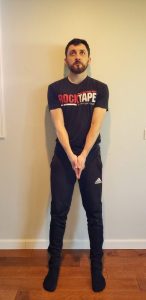
The Movement
- While maintaining contact with the wall, try to bring your elbows together, hands still clasped, while you reach out as far as you can in front of you, effectively protracting the scapulae and activating the serratus anterior. Bend your elbows while raising your arms towards your head.

- While keeping the elbows together, touch your hands to the very top of your head (not too high, the shoulder may become impinged).
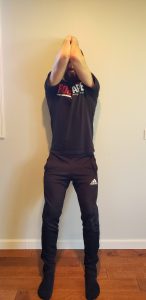
- With the fingers touching atop your head and acting as a hinge, slowly open the elbows and squeeze the shoulder blades together. Now we’re in the “backfield” and the shoulder bladess should be retracted.
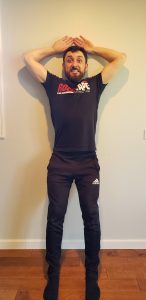
- While keeping your fingers, wrists, and elbows against the wall, let your fingers come apart and commence “angel-ing”, however, instead of arms straight or slightly bent, we cue the client to turn into a tight “W” – pulling the elbows down against the body and keeping the hands high.
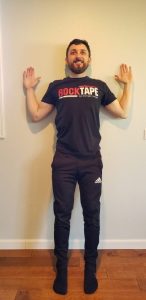
- Relax the biceps, again with elbows/wrists/fingers against the wall until we’re in “Brugger’s Postural Relief Position” (basically Anatomical Position) with the palms facing out and elbows fully extended.
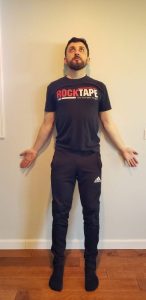
- Bring it back to center and repeat! 10 each direction, the reverse direction is the same cues only backwards, always start from center to keep it easy.
Note: On the reverse, women may find it uncomfortable as they encounter “chest” tissue; simply ask the individual to go as far as they can until they bump into said tissue, and move on to the next cue from there.
Wall Knee Tracking
Regardless of what you call it, this exercise has the potential to be a tri-planar self-assessment warm-up/cool-down stretch and treatment All-In-One. I teach this to ALL of my lower extremity patients and at any given game I’m playing in, you’ll see me doing this before and after, and sometimes during. Do as follows:
Starting Position
- Hands against a wall, in a front stance, or calf stretch position, with the front foot firmly planted on the ground and front knee bent with tibia generally vertical. Back foot should be pointed straight ahead with hips squared to the wall.

The Movement
- With hands on the wall and heel and toes of the front leg pointing directly towards the wall while planted firmly, bend the front knee directly towards the wall over the ankle, leading it into dorsiflexion.
- Oscillate forward and backward slightly, like a bouncy stretch. This should take about 5-10 seconds to assess if you have movement, or where the tightness/stiffness is in the LE (lower extremity). Is it in the calf? The knee? The hammy? The front of the ankle? The plantar fascia?

- Next, drive the knee (from the starting position) medially and forward, working internal rotation of the tibia. Do this for 5-10 seconds, bouncing in and out and around the position to assess. The arch will drop on this one…it’s not a bad thing.
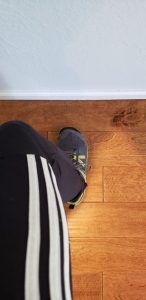
- After front and middle, try the outside. This is the hard one for most people – I typically cue that you should be able to see all of your toes to the inside of your knee if you look down. You should notice the arch raise, but the heel and toes should remain on the ground.

Congrats! You’ve done ¼ of the exercise! Repeat on the other side and you’re ½ done!
Now for the back leg exploration:
- From the same start position, back foot planted and toes pointed straight ahead, place your hands on the wall for support and take a lateral step with the front foot and hold 5 to 10 seconds.
- Then take a medial step with the front foot jussssst over the midline of the body (so legs are slightly crossed). Same timing, 5-10 seconds hold.
- Repeat on the other leg
Sanchin Kata
This is a detailed, flowing movement said to unify body, mind and spirit. Sanchin comes from Goju Ryu, one of the more traditional and rooted martial arts. Try this in the AM and see if it isn’t the shot of espresso you desperately needed. To explain it further, it is a full-body-tension, slow and controlled breathing exercise that will get your core, low back, hips, shoulders, wrists, and elbows prepped for the day.
The Movement
Rhythmic and simple. My favorite example is by the Master himself, Morio Higaonna.
https://www.youtube.com/watch?v=kybxNOlnl20
These exercises will feel better with progress! Be sure to remind your clients with regard to perfect form: “This is the goal, NOT the expectation!”
___________________________________________
Dr. Patrick K. Silva is a Board Certified and Licensed Doctor of Chiropractic with a focus on Sports Rehab, practicing in the beautiful US Pacific Northwest. Building on his preceptorship with the Seahawks' chiropractor (Dr. Jim Kurtz) in 2016, Dr. Patrick has designed his practice around the numerous soft tissue techniques, movement systems, and rehabilitative paradigms that modern sports science has to offer. Dr. Patrick is also a Certified Office Ergonomics Evaluator and Certified Professional Trainer. In his spare time, Dr. Patrick enjoys DIY projects and stays active practicing martial arts, soccer, dodgeball, parkour, and gaming.


